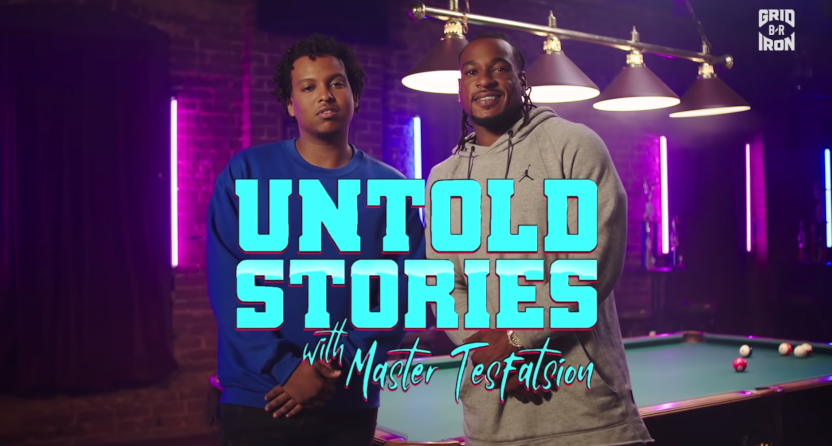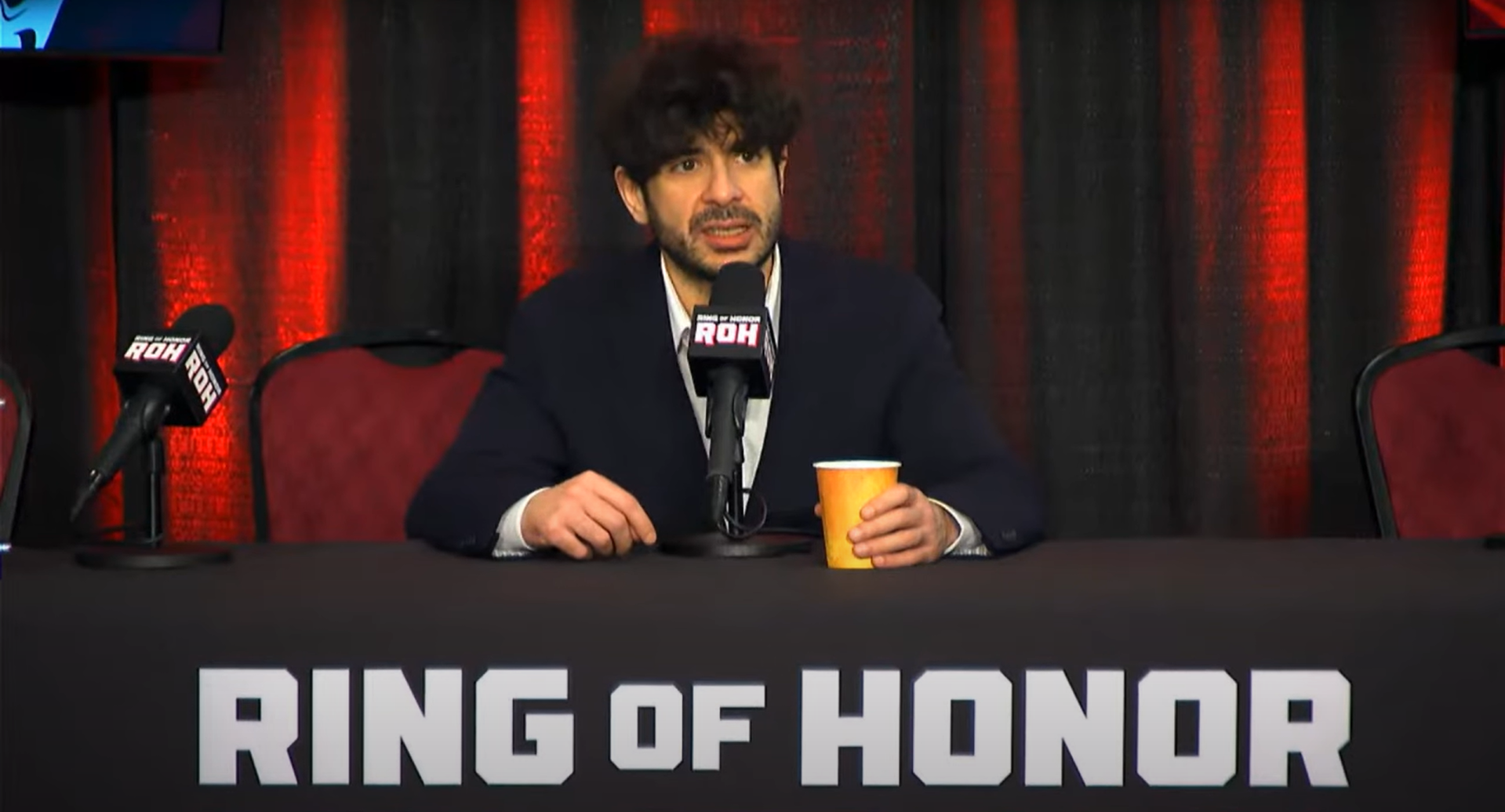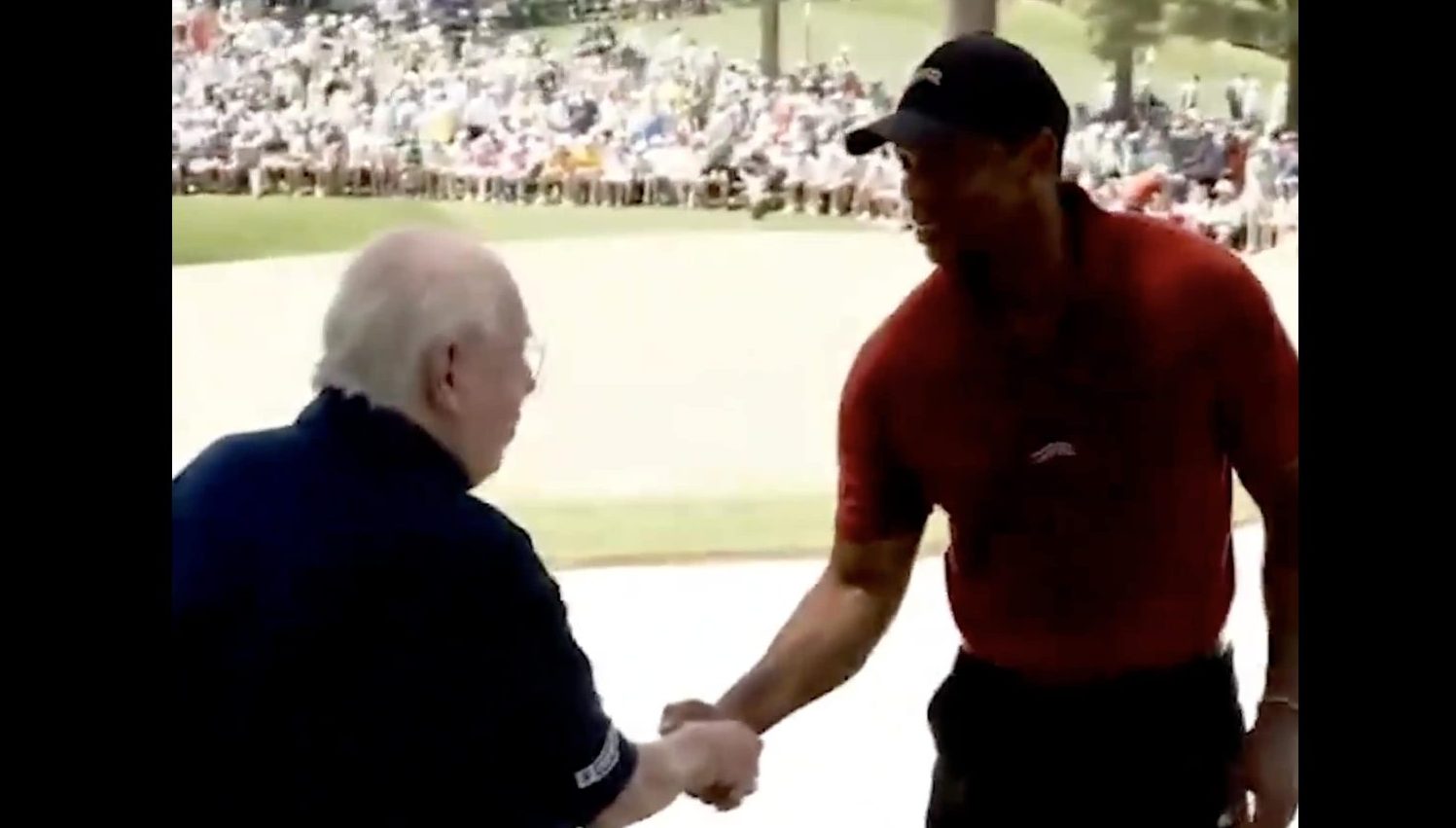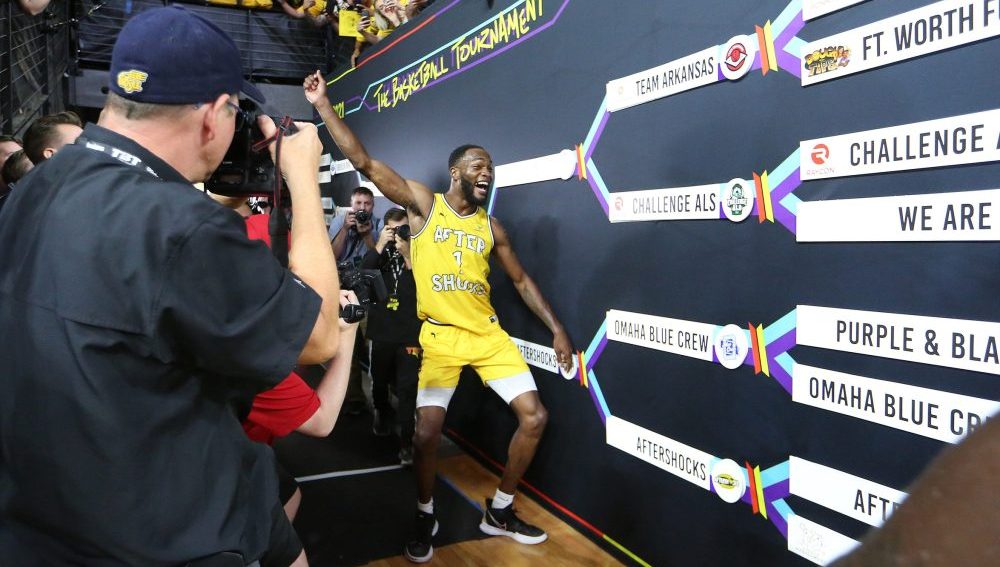After working for MLB.com, The Minneapolis Star-Tribune and The Washington Post, Master Tesfatsion joined Bleacher Report in January 2018, and he’s made an impact there with both written and video work. His new video series, Untold Stories with Master Tesfatsion, is one of two original NFL-focused video shows B/R launched this year under the B/R Gridiron brand (the other one is Ditch The Playbook with Lefkoe, hosted by Adam Lefkoe), and it made a particular impact recently thanks to an interview with Percy Harvin, where Harvin (seen at right above with Tesfatsion) said he was high on marijuana (to address anxiety issues) before every game he played.
Untold Stories features an unusual approach, and it’s very distinctive visually. It has Tesfatsion talking with the players over a game of pool, and it has the players’ comments illustrated with animation. But it’s also notable for its content; other Untold Stories segments have included Jamaal Charles talking about almost fighting Larry Johnson over rookie hazing and Antonio Cromartie saying he was cut for kneeling in protest. Tesfatsion spoke to AA earlier this month, and he said he thinks he’s able to connect to these former NFLers thanks to having a similar background to many of them, which helps in getting them to open up.
“I think it’s the relatability. More than 85 percent of the NFL players are black, and I think football comes from a very interesting perspective. It’s viewed, oftentimes, from African Americans who grew up in poverty, as an opportunity to improve their socioeconomic background. That’s something that, growing up in Texas myself, that I wanted to pursue. And understanding how growing up myself in poverty, growing up in very hard, difficult circumstances and situations, seeing football in that kind of light is kind of relatable to a lot of these athletes who do as well. Being able to bond on them either in that kind of perspective or bonding on them culturally, where we have a lot of similarities.”
Tesfatsion said he wants Untold Stories to be a place where these athletes can talk about whatever they want in a way the NFL didn’t always encourage them to.
“And it’s also just being able to give them an opportunity to kind of let their guard down and knowing that ‘You can keep it a buck on this show. You can speak your truth on this show.’ And oftentimes in the NFL, it’s not allowed, because there’s such a militarized structure when you talk about the NFL. There’s a famous phrase that the Patriots use all the time; ‘Do your job.’ And it’s basically ‘Do your job or you’re going to get cut.’ You can’t be who you really want to be, you can’t be yourself. You can’t be authentically you. And this platform allows that.”
“It allows them to be authentically themselves in a way that I personally understand too. Because I’ve been in locker rooms now for going on seven-plus years. So being able to understand the locker-room dynamic, being able to be around athletes for that long of a period of time, that level of experience with them has helped me out tremendously. And being able to have the rapport and relationship and the sourcing of how a locker room is structured, how a NFL team is structured, and understanding how there’s a lot of things that these athletes want to say that they’re not able to say, particularly in the NFL.”
The video series with Bleacher Report is a newer endeavor for Tesfatsion, as much of his earlier B/R work was on the written side, and his work at the Post was mostly written (he was a Redskins beat writer there). However, he said it’s bringing him back to his roots in journalism.
“Actually, I started doing video before I ever started writing, back in high school. I don’t think a lot of people know that; I came up through newspapers, so everyone always just assumed that writing was kind of the pathway that I wanted to go, but I didn’t really start writing until my sophomore year in college. Before that, it was a heavy broadcast emphasis. And that stemmed back from high school; we had a media tech program.”
“Our school is very interesting. It’s Jack E. Singley Academy in Irving, Texas. Basically you kind of have to specialize in a “major,” so you can specialize in like legal, the medical field, IT, the arts. And I did media tech, honestly because I heard it was an easy A. So I try to do it and the next thing I found out was that I really enjoyed creating things and I really enjoyed the creative process. That started in my freshman year of high school, and just learning how to edit on Premiere initially and then learning how to edit on FinalCut after that and Avid as well, I don’t think anyone in the industry uses Avid. From there, it’s kind of being able to direct, produce, being able to play around with a lot of different media avenues.
“And my degree from Arizona State is actually in broadcast journalism, so I continued with the broadcast degree. But my sophomore year of college, I decided to switch over and start kind of focusing and emphasizing the writing. Because I started realizing everyone that was on TV had a strong print background. And I felt like that formula is still very effective in terms of understanding the fundamentals of print, having that as your foundation of who you are as a journalist, as a storyteller, as a reporter. I felt that that was essential for me to get where I need to be, and for me be as great as I can be.”
“So I went with that full steam ahead from my sophomore year at college, and it opened up some great doors and some great opportunities, like interning for a year at ESPN Dallas, The Seattle Times, MLB.com covering the Rangers as an associate reporter with T.R. Sullivan, a legend in the game. And then from there, it opened up doors for me at the (Minneapolis) Star-Tribune and The Washington Post.”
Tesfatsion said returning to video has long been a priority for him, though, and he was able to get some work in on that side in some previous jobs, especially at the Star-Tribune.
“But I always knew at some point I wanted to get back to the video side. And actually when I was at the Star-Tribune, on top of writing there and being a beat writer, I was doing three videos a week in which I was in the studio by myself directing it, writing the script, editing it, posting it up on StarTribune.com. I was doing that for a weekly preview show, was doing the interviews inside the locker room that led up to pregame, was carrying camera equipment with me at every road game and chopping up our Access Vikings footage and also chopping up something of my own.”
“So it’s something that’s always been around. At The Washington Post, it wasn’t as much, but thankfully here at Bleacher Report, Sam Toles and Howard Mittman really believed in me and believed in this opportunity and gave me Untold Stories. Once I knew I had that opportunity, I wanted to make the most of it, and I’m really happy with where it’s at right now. And I understand the impetus of providing players and athletes the opportunity to just be themselves, and being able to share what goes on behind the scenes, and creating a safe haven for for these athletes in a way that they’ve never really experienced before on camera. It’s been a joy to just be a part of the process and and I’m just fortunate and blessed to be the host of this.”
He said an important part of Untold Stories is that it’s not all serious and heavy. For every conversation like the one with Harvin, there’s Chris Johnson talking about an epic night out that led to $140,000 in fines, or Clinton Portis talking about having his best game when he was hungover.
“As you can see, there’s a range of perspectives, too,” Tesfatsion said. “That was another thing that I wanted to make sure, this wasn’t going to be just a very serious show or a very funny show. I wanted to display range. You can show a Clinton Portis who talks about how his greatest game was hung over, and understand the reality of how that exists. Because these athletes like to party just like we do.”
But Tesfatsion said the show works because it can cover both the light and the serious, and he thought the Harvin conversation was particularly valuable.
“And being able to have a platform where you can express that, but then also you can express something as serious and significant in today’s culture as mental health, in particular with Percy Harvin, black mental health, which a lot of people really related to and understood. Being able to see his maturation and his growth in a way that I don’t think we typically see from NFL players, because I’m not particularly sure they’re ever given the opportunity or platform to grow. They’re given so much responsibility and put in the limelight at such a young age, when they grew up in circumstances and situations in which nobody else around them can relate to or fathom for this level of success or this level of notoriety. And dealing with that pressure or dealing with how you’re going to handle that situation can cause a lot of anxiety for a lot of these guys.”
“And being able to hear someone like Percy Harvin, who openly and honestly could speak about what he’s gone through, and you can hear it in his own voice and you can hear in the way that he’s talking, it’s something that since he’s left the NFL, he’s found that peace, he’s found that comfort. And he’s now hoping to teach and help other people learn from his mistakes. And he has that platform now and that opportunity to share what he’s learned to other people who, not only just in the NFL that can relate to that, and in sports that can relate to that, but also just to us as people in general.”
Back to Tesfatsion himself, he said his 2018 move from the The Post to Bleacher Report caught many people by surprise, but he did it because their platform allowed him to focus on reaching a younger audience.
“I think a lot of people were shocked when I made the move. Actually, I know a lot of people were shocked. There were a lot of people that came up to me and said ‘Why would you leave The Washington Post? And for me, at least, Bleacher Report is the audience I want to speak to. I’m 28 years old, and being able to have a platform that allows me to speak directly to millennials and Gen Zs in a way that no other sports platform can was huge for me.”
The latest
“They just want something different. And Bleacher Report has allowed me that creative freedom and that opportunity, to do that not only just in the written platform, but now also on video. And it will be exciting to see where this goes moving forward.”
He said he’s also excited by the colleagues he works with at B/R, and under the larger Turner umbrella.
“And it’s not just me that’s able to have this freedom. As you look at the entire sports landscape now with what Bleacher Report is doing, you’ve got Taylor Rooks, who’s also having open conversations on her show, Take It There. We’ve got Howard Beck doing columns and openly talking about the China-NBA situation, the same thing obviously with The NBA on TNT and Inside The NBA, the Turner/Bleacher Report family. I feel like Inside The NBA and how open and candid and honest that they are in their perspectives kind of sets the tone for Turner and Bleacher Report on both sides. Because you realize that that’s within our family, that’s within our company, and that’s kind of what we see and we look up to when we understand the importance of being able to have that kind of platform. It’s great to be able to kind of share those same qualities with Bleacher Report for not just myself but also my colleagues.”
Tesfatsion said he thinks there’s a lot more to come with Untold Stories, and with his work with B/R in general.
“I think this is just the start. And I’m excited to see where this thing goes because I feel like it has, I know it’s my show, but I think we all collectively do feel like there’s a lot of potential here with what we’ve done. And we’re just getting started.”






